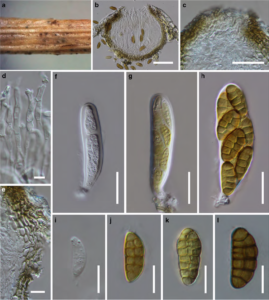Dematiopleospora luzulae Wanasinghe, Camporesi, E.B.G. Jones & K.D. Hyde.
Index Fungorum number: IF551410; Facesoffungi number: FoF00949; Fig. 1
Etymology – Name reflects the host genus Luzula from which the species was collected.
Holotype – MFLU 15 – 1503
Saprobic on dead stem of Luzula sp. Sexual morph: Ascomata 140 – 160 μm high, 175 – 200 μm diam. (x̄ = 148.4 × 184.5 μm, n = 10), immersed, solitary, scattered, globose, brown to dark brown, coriaceous, fusing with the host tissue, ostiolate. Ostiole 25 – 40 μm high, 30 – 50 μm diam. (x̄ = 29.5 × 36.2 μm, n = 5), black, smooth, upper covering of ostiole, comprising short, light brown setae-like structures. Peridium 10 – 20 μm wide at the base, 10 – 15 μm wide at the sides, comprising 3 – 4 cell layers of thin – walled, brown cells of textura angularis, inwardly lighter. Hamathecium comprising numerous, 2 – 3 μm (n = 30) wide, filamentous, branched, septate, pseudoparaphyses. Asci 70 – 80 × 15 – 20 μm (x̄ = 76.4 × 18.1 μm, n = 40), 8 – spored, bitunicate, fissitunicate, cylindric-clavate, short pedicellate, rounded and thick walled at the apex, with an ocular chamber. Ascospores 15 –20 × 7 – 10 μm (x̄ = 19.3 × 8.6 μm, n = 50), overlapping biseriate, initially hyaline, becoming brown at maturity, ellipsoidal to oval, some curved, muriform with 4 – 6 transverse septate and 3 – 4 vertical septa, strongly constricted at the central septa, the two cells rows above the central septum wider, weakly constricted at the other septa, conical and narrowly rounded at the ends, surrounded by a thick, hyaline, mucilaginous sheath. Asexual morph: Undetermined.
Culture characteristics – Colonies on PDA reaching 30 – 35 mm diam. in 21 days, olivaceous-grey, spreading with moderate aerial mycelium, with smooth, even, margins; reverse iron-grey.
Material examined – ITALY, Trento Province, Mezzana, Marilleva 1400, on dead stem of Luzula sp. (Juncaceae), 1 August 2013, E. Camporesi (MFLU 15-1503, holotype); extype living culture, MFLUCC 14-0932.
Notes – Dematiopleospora luzulae is introduced as a second species of Dematiopleospora and has muriform ascospores similar to those characterized in Pleospora (Zhang et al. 2009a, b). Dematiopleospora luzulae resembles D. mariae in having brown, periphyses in the ostiole, a peridium comprising brown to dark brown cells of textura angularis and muriform ascospores, but differs in having ascospores without light end cells.

Fig. 1 Dematiopleospora luzulae (holotype). a Appearance of ascomata on host substrate b Section of ascoma c Close up of ostiole d Peridium e Pseudoparaphyses f – h Asci i – m Ascospores. Scale bars: b = 50 μm, c = 20 μm, d = 10 μm, e = 5 μm, f – h = 20 μm, i – m = 10 μm.
